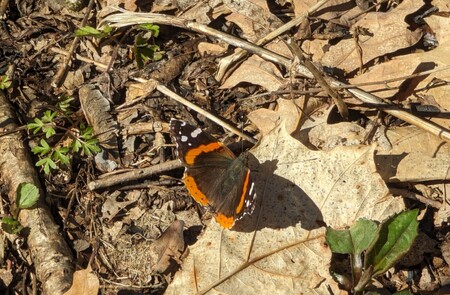
Good Natured: Red Admirals
I don't think of admirals often (you can blame my family's Army heritage for that). But when I do, I think of three things:
- Our 1970s neighbors' Admiral television—it was COLOR!
- Admiral Reynolds on McHale's Navy (in black and white, even on the color TV)
- Red admiral butterflies, always glorious in black and white, and reddish orange!
Now, actually seeing these various types of admirals is another matter entirely.
It's been 50 years since I last watched television at the Duncans' house. (Shoutout to my brother though for helping with the TV recall. An electrical engineer, he corrected me when I thought we'd had an Admiral in the family. He said, and I quote, “The Gratteaus (cousins) had a tube RCA, the Atterberrys (Mom's family) had an RCA XL100 solid state, Grandma Erickson (Dad's mom) had the Zenith Chromacolor hybrid and La (aunt) and we didn't get color until '77, which were Zenith Chromacolor II." He's amazing!)
As for seeing Admiral Reynolds, it appears that McHale's Navy reruns can be found on a variety of streaming services, as well as in boxed CD sets.
And those red admiral butterflies? All you need to do is go outside.
For the past two weeks these spritely signs of spring, also known as Vanessa atalanta, have been fluttering about the woods and neighborhoods of eastern Kane County. I counted seven admirals, plus one lady, (either American, V. virginiensis, or painted, V. cardui) the other day when I was walking the dogs, and we only went around the block. Two days later I spotted a dozen on a walk from Good Natured Headquarters to the Pottawatomie Community Center and back again, a distance just under two miles.
Then the emails started coming in. A red admiral at Mt. St. Mary Park. Another one at Wheeler Park in Geneva. And a third from a Good Natured reader who described the butterflies as monarchs—a common tendency, as their red-orange and black markings often appear as a blur when they flutter by.
Hmm. Even a blockhead like me could tell, a pattern was developing. I made a note to myself to head out one more time before sitting down to write this column, to see how many red admirals I could spot in, say, 30 minutes.
Alas, the weather was no bueno—well, at least for butterflies. Though sunny and clear out, it was windy. Or maybe I should say WINDY. Amid sustained speeds of 25mph and gusts even higher, the only butterflies I could find were ceramic ones on posts in a neighbor's yard.
So I did the next best thing… I texted my friend Terri, who participates in the Illinois Butterfly Monitoring Network. While it was just as windy at her house, she did say that she'd seen three red admirals in her yard earlier in the week. Yippee!
April might seem early to be seeing butterflies, but for red admirals it's par for the course. It's only now though that we're beginning to understand why.
My little Golden Guide to Butterflies and Moths, published in 1964, has been my go-to resource for Lepidopterans since my grandfather bought it for me in 1968. Today, when I looked up red admirals, the old reassuring text described their coloration, their diet and their overwintering strategy. In two concise words it states: Adults hibernate.
But you know what? That good old guide book is now outdated. Thanks to hard-working entomologists, we now know that that statement clearly is wrong. Or at the very least, isn't 100% correct.
Careful observation has shown that many red admirals migrate.
While not the transcontinental route undertaken by our most famous butterfly, the monarch, Danaus plexippus (which, by the way, wasn't completely mapped out until 1975, with the discovery of their southern terminus in central Mexico) red admirals still move impressive distances south in fall and north in spring.
Still, I noticed there was quite a bit of variance in the condition of the red admirals fluttering around St. Charles. Many appeared to have some wear on their wings, indicating they've been travelling. But others look unscathed. Brand-spanking new, really. Were they just lucky? Or did they overwinter here, as either an adult or pupae?
These are the sorts of mysteries that keep us nature nerds up at night. Luckily, science is hot on the heels (tarsi?) of these intriguing insects. Just west of us here in Illinois, at Iowa State University, Dr. Royce Bitzer oversees the Red Admiral and Painted Lady Research Site (https://vanessa.ent.iastate.edu/ ) and encourages butterfly fanciers from across the country to report their sightings of red admirals and their Vanessa kin. As an additional avenue for reporting, he created the Vanessa Research Project (https://www.inaturalist.org/projects/vanessa-migration-project ) in March of 2016.
It's pretty easy to contribute to this important research. Participants only create an account, then log in with their observations of species, date and location. Wind speed is helpful too; there's also a box marked Description/Notes for any other pertinent information about the sighting.
If you're so inclined, give this community science effort a try! Entomologists working to sort out the intricacies of butterfly life cycles will thank you for it, and admirals—the red ones—will too.
Pam Otto is the outreach ambassador for the St. Charles Park District. She can be reached at potto@stcparks.org.

